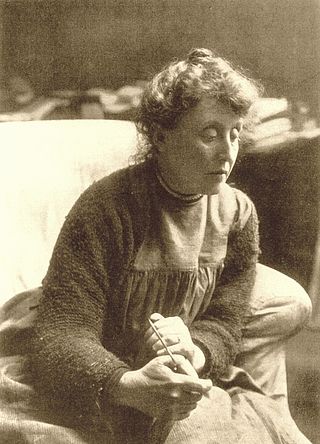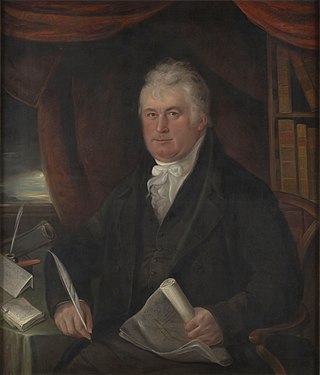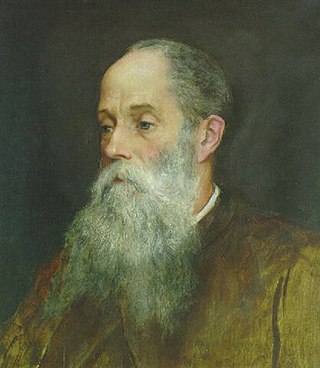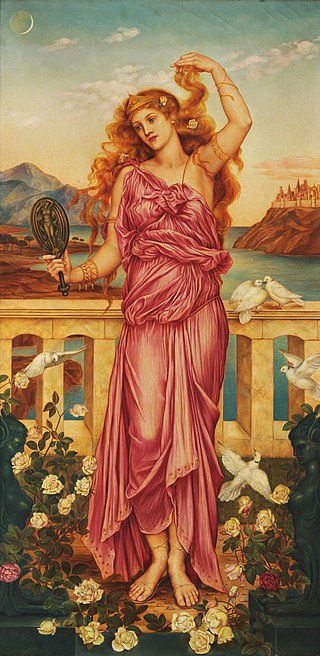
William Frend De Morgan was an English potter, tile designer and novelist. A lifelong friend of William Morris, he designed tiles, stained glass and furniture for Morris & Co. from 1863 to 1872. His tiles often recall medieval or Islamic design patterns. He applied innovative glazes and firing techniques. Galleons and fish were common motifs, as were "fantastical" birds and animals. Many of De Morgan's tiles were designed to create intricate patterns when several were laid together.

Cannon Hall is a country house museum located between the villages of Cawthorne and High Hoyland some 5 miles (8 km) west of Barnsley, South Yorkshire, England. Originally the home of the Spencer and later the Spencer-Stanhope family, it now houses collections of fine furniture, paintings, ceramics and glassware. It at one time housed the Regimental Museum of the 13th/18th Royal Hussars and the Light Dragoons, which has now closed. Now occupying four rooms in the east wing is the "Family of Artists" exhibition on loan from the De Morgan Foundation, which draws on the links between the Spencer Stanhopes and the De Morgans.

Evelyn De Morgan was an English painter associated early in her career with the later phase of the Pre-Raphaelite Movement, and working in a range of styles including Aestheticism and Symbolism. Her paintings are figural, foregrounding the female body through the use of spiritual, mythological, and allegorical themes. They rely on a range of metaphors to express what several scholars have identified as spiritualist and feminist content. Her later works also dealt with the themes of war from a pacifist perspective, engaging with conflicts such as the Second Boer War and World War I.

Thomas William Coke, 1st Earl of Leicester, known as Coke of Norfolk or Coke of Holkham, was a British politician and agricultural reformer. Born to Wenman Coke, Member of Parliament (MP) for Derby, and his wife Elizabeth, Coke was educated at several schools, including Eton College, before undertaking a Grand Tour of Europe. He returned to Britain and married. When his father died he inherited a 30,000-acre Norfolk estate. Returned to Parliament in 1776 for Norfolk, Coke became a close friend of Charles James Fox, and joined his Eton schoolmate William Windham in his support of the American colonists during the American Revolutionary War. As a supporter of Fox, Coke was one of the MPs who lost their seats in the 1784 general election, and he returned to Norfolk to work on farming, hunting, and the maintenance and expansion of Holkham Hall, his ancestral home.

John Roddam Spencer Stanhope was an English artist associated with Edward Burne-Jones and George Frederic Watts and often regarded as a second-wave pre-Raphaelite. His work is also studied within the context of Aestheticism and British Symbolism. As a painter, Stanhope worked in oil, watercolor, fresco, tempera, and mixed media. His subject matter was mythological, allegorical, biblical, and contemporary. Stanhope was born in Cawthorne, near Barnsley, Yorkshire, England, and died in Florence, Italy. He was the uncle and teacher of the painter Evelyn De Morgan and encouraged then unknown local artist Abel Hold to exhibit at the Royal Academy, which he did 16 times.

The Love Potion is a 1903 painting by the English artist Evelyn De Morgan depicting a witch with a black cat familiar at her feet. According to Elise Lawton Smith, the painting "exhibits a Pre-Raphaelite fascination with medieval subjects and decorative detailing." The model was Jane Morris.

Walter Spencer-Stanhope, of Horsforth and Leeds, Yorkshire, was a British industrialist and a politician who sat in the House of Commons for various constituencies between 1775 and 1812.

The Hogarth Club was an exhibition society of artists, based at 84 Charlotte Street, Fitzrovia, London, UK, which existed between 1858 and 1861. It was founded by former members of the Pre-Raphaelite Brotherhood after the original PRB had been dissolved. It was envisaged that the club would provide an alternative meeting space and exhibition venue to overcome prejudice against the Pre-Raphaelites at the Royal Academy. Unlike the PRB, the Hogarth Club was established on a professional basis, with two classes of members, artistic and non-artistic, and a distinction between London-based "resident" and provincial "non-resident" members.

Helen of Troy is an 1898 painting by the English artist Evelyn De Morgan depicting Helen of Troy; it was commissioned by William Imrie of Liverpool.
Gertrude Spencer-Stanhope (1857–1944) was an English sculptor and painter. She was the niece of John Roddam Spencer-Stanhope and the cousin of Evelyn Pickering De Morgan, both of whom were noted pre-Raphaelite painters.

Anna Marie Diana Wilhelmina Stirling, also known as Wilhelmina Stirling and under the alias Percival Pickering, was a British writer and art collector. A greater part of her books dealt with the lives and reminiscences of the British landed gentry of Yorkshire. She was the founder of the De Morgan Centre for the Study of 19th Century Art and Society.
Sir Walter Thomas William Spencer-Stanhope was a British Conservative politician and Volunteer officer.

The Oxford Union murals (1857–1859) are a series of mural decorations in the Oxford Union library building. The series was executed by a team of Pre-Raphaelite artists including Dante Gabriel Rossetti, William Morris and Edward Burne-Jones. The paintings depict scenes from Arthurian myth.

Thoughts of the Past is an oil painting on canvas by English Pre-Raphaelite artist John Roddam Spencer Stanhope, first exhibited in 1859 and currently housed at Tate Britain.

Love and the Maiden is an oil painting on canvas by English Pre-Raphaelite artist John Roddam Spencer Stanhope that is currently housed at the Fine Arts Museums of San Francisco.
The De Morgan Foundation is a charity registered with The Charity Commission For England And Wales, Registered Charity No. 310004 since 1970.
John Spencer Stanhope (1787–1873) was an English landowner and antiquarian.

Old Battersea House is one of the oldest surviving buildings in Battersea, South West London and is Grade II* listed. It was built around 1699, and was once rumoured to have been designed by Sir Christopher Wren.

Horsforth Hall Park is a 3.38 hectares community park in Horsforth, West Yorkshire, England, approximately six miles from Leeds city centre.
Percival Andree Pickering was an English first-class cricketer and lawyer.















